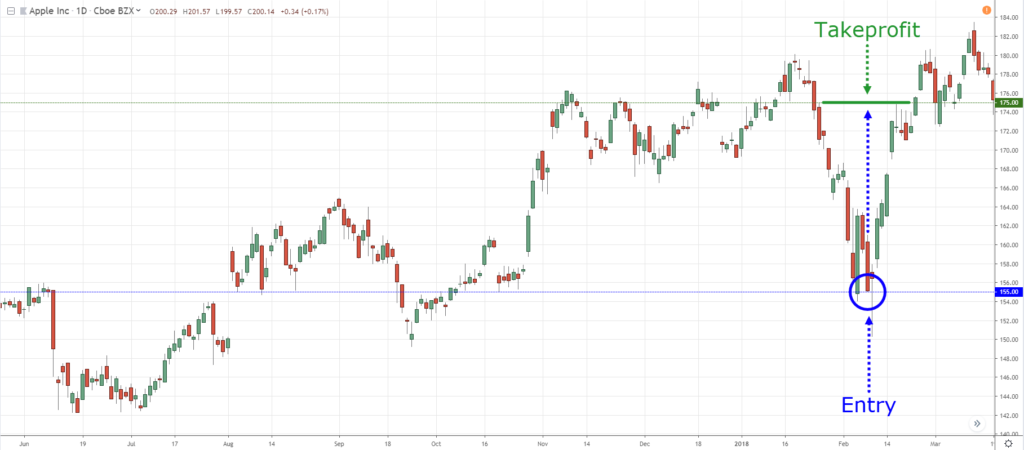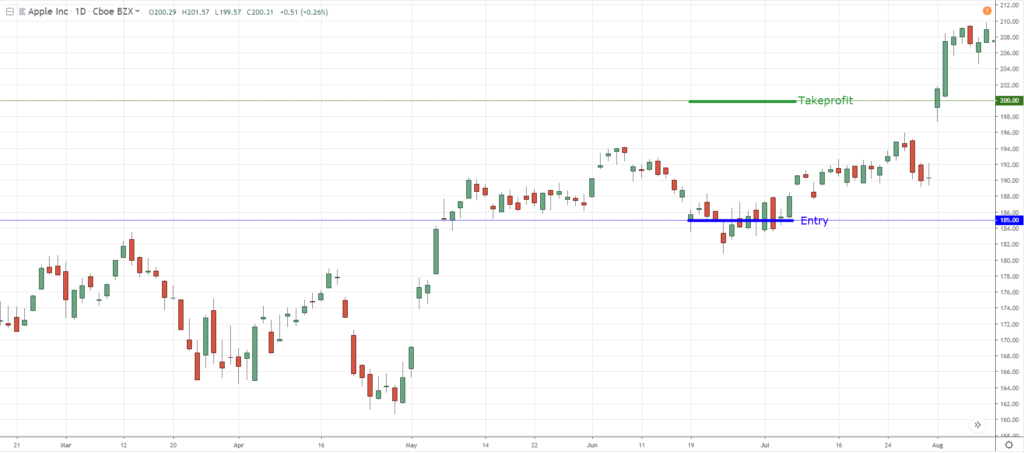#2: How To Calculate Stock Returns
Lesson 2
Moving on…
Let’s discuss how you can actually profit from stock trading.
How to profit from a stock
There are two ways to do it:
- Buy low sell high
- Buy high sell higher
Buy low sell high
This is something that you probably have heard many times.
But here’s a quick example in Apple (AAPL) wherein you bought one stock at $155 per share, and sold it at $175…
The difference between your selling price and your buy price is $20!
Which means, you made a profit of $20 per share on Apple.
Another way that you can profit from stock trading is this…
Buy high sell higher
This is a concept that’s hardly talked about.
Everybody talks about you know buying low and selling high.
But this is an even more important concept if you ask me.
Let me give you an example on Apple (AAPL) where you buy on the break out of $185 and moved all the way up to $200 per share…
What’s your profit?
Just take your selling price minus your buying price, and you have a profit of $15.
If you had a thousand shares, you would have a profit of $15,000.
But this time, you are actually buying high and this could be psychologically different from most people.
You might be saying, “Oh man! you are buying at such a high price when the market is about to reverse!”
Here's the thing…
You never know how high or how low a stock can go.
That’s why there's another way to profit which is to buy high and sell higher.
Don't worry about the precise entries or techniques or when to sell, we’ll cover all of that later in the course.
But for now, I just want you to understand the concepts behind profiting in the stock market.
Moving on…
How do you actually calculate your stock trading returns?
There are three ways to do it…
- Dollar
- Percent
- R Multiple
Let me explain again…
Dollar
This approach is something that I’ve briefly covered earlier.
So what you'll do is just to calculate the difference between your selling price and buying price.
If you bought a stock at $150 and sell it at $200 per share…
Your profit on a stock is $50 per share.
If you bought 1,000 shares on a stock that’s $150 per share…
Once you sell it at $200 your profits would be $50,000
Next…
Percentage Return
This one is a little bit different but really simple.
Let's say you buy Apple (APPL) selling $100 a share.
And let's say you sell it at $150 dollars.
What is your percentage return?
Just calculate your profit divided by the initial share price that you bought.
In this case, you can see that the profit is $50 per share divided by the initial price that you bought which is $100, then…
You get a profit of 50%
Simple?
The last one is what I call…
R Multiple
This is actually my favorite approach to calculate returns whether you're trading Forex, Options or whatever.
Why is that?
Because when you calculate returns based on dollar or percentage, it does not calculate or determine the amount of risk that you're taking to achieve those returns.
I'll explain.
Trader A
So let's say trader A plans to buy Apple shares at $100 per share and plans to sell it at $150.
However, for this particular trade of Apple, you're either going big or going home.
Trader A tells himself, “If Apple drops to $0, I’ll still hold it!”
You can see that trader A’s entire risk on this trade is a full $100 and the profit in his trade would be $50.
Now, divide the potential risk ($100/$100) and the potential profit ($50/$100) and you can see that trader A is actually risking $1 to make $0.5
From a risk to reward standpoint, this is not too attractive if you ask me…
Risk: $1
Reward: $0.5
Now, let’s compare this to another trader who bought Apple shares at $100 and sold it at $110.
Trader B
The potential profits are much smaller but this trader now has a stop loss or a predetermined exit price.
Let's say that trader B’s exit price is $95.
Now ask yourself…
What is this percent risk per trade?
Subtract $100 (entry price) from $95 (stop loss price), and you get -$5 risk of the trade.
How about the reward per trade?
Subtract $100 (entry price) to $110 (take profit price) and you get a potential +$10 reward of the trade.
Now, you can see that he's risking $5 to make $10!
Risk: $5
Reward: $10
And if you just keep things simple, you’ll realize that trader B is actually risking $1 to make $2
Compared to the trader earlier who has a bigger potential profit of $50, but has a bigger risk of $100, basically risking $1 to make $0.5
Which is a better trader?
If you ask me, from an R multiple standpoint, trader B did a better trade.
You can look at trader B in two ways:
- Risking $1 to make $2
- Multiple of 2R
Another example is that if someone made a profit of 10R…
This means that he risks $1 to make $10
So these are the three different ways to calculate your stock returns.
But I find that the R multiple is the most objective measure to calculate your stock returns.
With that said, let's do a quick summary…
Summary
- To profit from stocks, you can either buy low or sell high or buy high and sell higher
- To calculate stock returns, you can use a dollar-based approach, percentage approach, or the R multiple approaches


